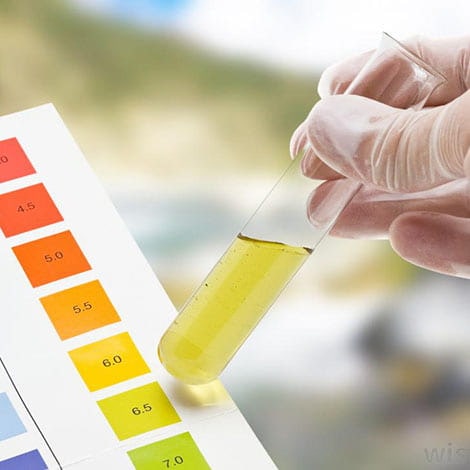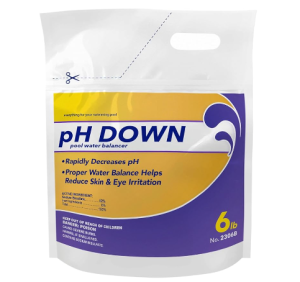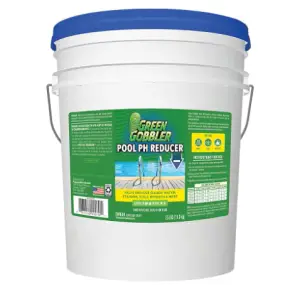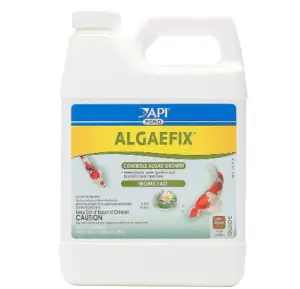Welcome to our guide on how to lower pH in a pond. Maintaining the right pH level in your pond is crucial for the health and well-being of your aquatic life. pH levels that are too high or too low can have detrimental effects on the plants and animals living in your pond. In this article, we will discuss the importance of pH in a pond, signs of high pH, methods to lower pH, and tips for maintaining the optimal pH level.
The Importance of pH in a Pond
Here Is A pH-Lowering Product For Pond And Pool
pH is a measure of the acidity or alkalinity of water on a scale of 0 to 14. A pH level of 7 is considered neutral, while anything below 7 is acidic and anything above 7 is alkaline. In a pond, the ideal pH level for most aquatic life is between 6.5 and 8.5. Maintaining the right pH level is essential for the overall health and vitality of your pond ecosystem.

Credit: landscapingbychuck.com
Signs of High pH in a Pond
High pH levels in a pond can lead to various issues such as poor nutrient availability, reduced oxygen levels, and decreased biological activity. Some common signs of high pH in a pond include:
- Excessive algae growth
- Sluggish fish behavior
- Decreased plant growth
- Cloudy water
Methods to Lower pH in a Pond
If you have tested your pond water and found that the pH level is too high, there are several methods you can use to lower it:
1. Use Ph-lowering Products
There are commercially available pH-lowering products specifically designed for ponds. These products are easy to use and can help lower the pH level quickly. Follow the manufacturer’s instructions carefully when using these products to avoid over-treating your pond.
Here Is A pH Lowering Product For Your Pond And Pool
2. Add Vinegar Or Citric Acid
You Can Use This Vinegar To Lower pH In A Pond
Natural remedies like vinegar or citric acid can also be used to lower pH in a pond. Mix the vinegar or citric acid with water before adding it to the pond to prevent sudden pH fluctuations. Monitor the pH levels regularly to ensure they stay within the optimal range.
3. Increase Aeration
Improving the aeration in your pond can help lower pH levels by increasing oxygen levels in the water. Consider adding aeration devices such as air stones or fountains to enhance oxygenation and promote the release of carbon dioxide, which can help reduce pH levels.
4. Perform Regular Water Changes
Regular water changes can help dilute the alkalinity in your pond and lower the pH level. Be sure to use dechlorinated water when performing water changes to avoid harming your aquatic life. Aim to change 10-20% of the water in your pond every 1-2 weeks.
Tips for Maintaining the Optimal pH Level
Once you have successfully lowered the pH level in your pond, it is essential to maintain it within the optimal range. Here are some tips to help you achieve and maintain the right pH level:
1. Test The Ph Regularly
Invest in a quality pH test kit and monitor the pH level of your pond regularly. Testing the pH weekly or bi-weekly will help you catch any fluctuations early and take corrective action promptly.
2. Avoid Overfeeding
Overfeeding your fish can lead to excess waste in the pond, which can contribute to high pH levels. Feed your fish only the amount they can consume in a few minutes to prevent overfeeding and maintain water quality.
3. Provide Adequate Shade
Excessive sunlight can cause fluctuations in pH levels in a pond. Provide adequate shade by adding floating plants, water lilies, or installing shade sails to help regulate the water temperature and prevent pH spikes.
4. Monitor Other Water Parameters
Aside from pH, it is essential to monitor other water parameters such as ammonia, nitrites, and nitrates. These parameters can also affect the overall health of your pond ecosystem and should be kept within the recommended levels.

Credit: landscapingbychuck.com
Conclusion
Maintaining the right pH level in your pond is vital for the health and well-being of your aquatic life. By following the methods outlined in this guide and implementing the tips provided, you can effectively lower the pH in your pond and create a thriving ecosystem for your plants and animals. Remember to test the pH regularly, monitor water parameters, and take proactive steps to maintain the optimal pH level. With proper care and attention, you can enjoy a healthy and balanced pond environment for years to come.





